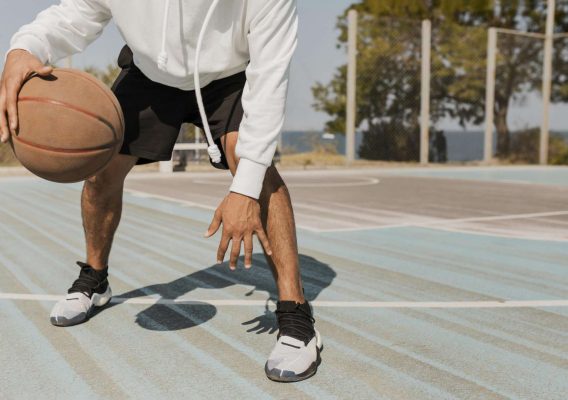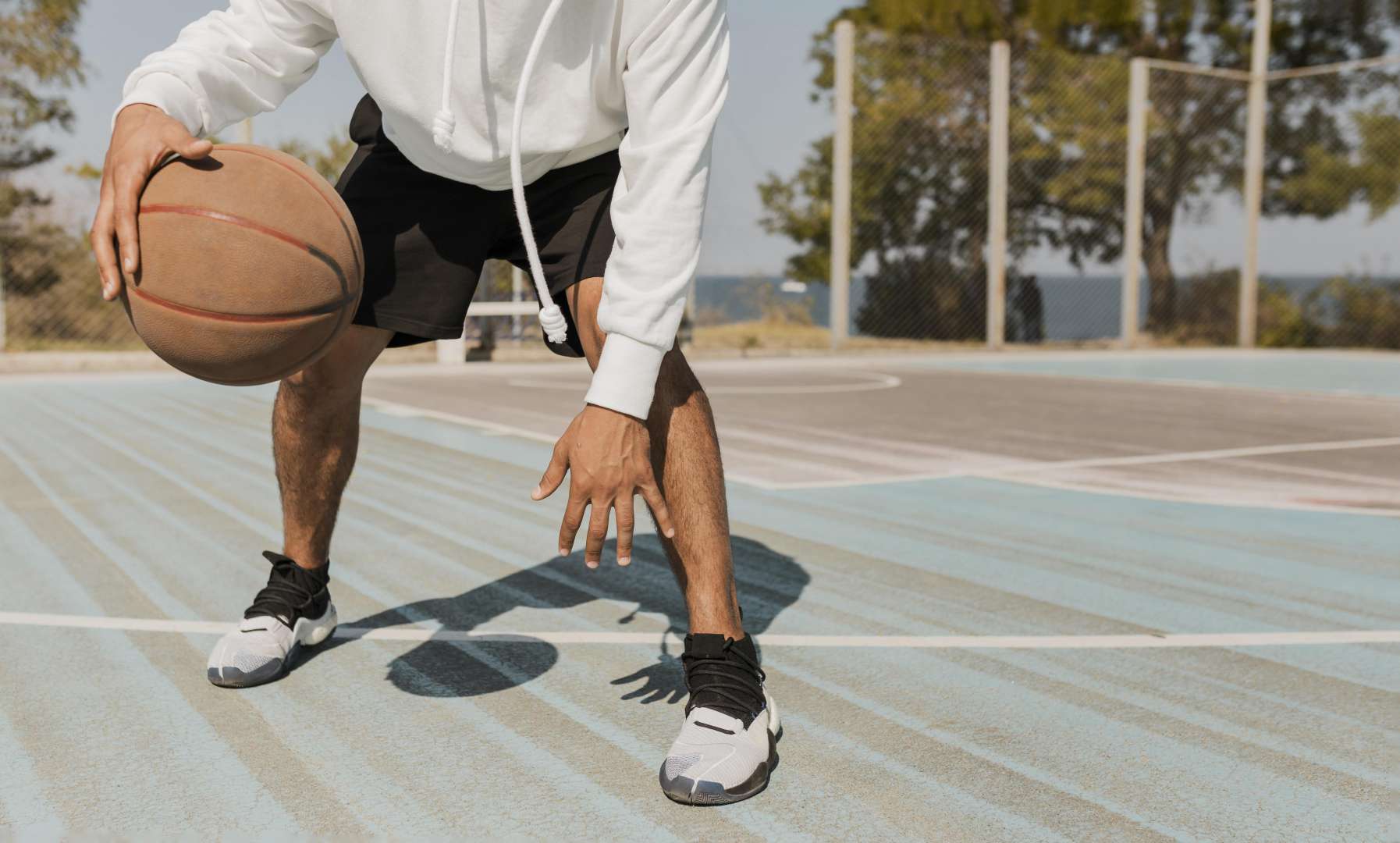Sustaining Sports Development by Strengthening its Industry
Youth I.D.E.A.S. 66
Economic Development
Sustaining Sports Development by Strengthening its Industry
Hong Kong athletes have performed very well in recent years. Historically, athletes from the Hong Kong team won 1 gold, 2 silver, and 3 bronze medals[1] in the Tokyo 2020 Olympic Games, and 2 silvers and 3 bronzes[2] in the Tokyo 2020 Paralympic Games, which made the public very excited. However, in terms of public participation in sports, multiple surveys have shown that the physical activity level of Hong Kong’s population is insufficient. The proportion of those who can meet the World Health Organization physical activity standard has been between only 35.7% and 43.6%[3] in recent years. Therefore, the promotion of community sports participation needs to be strengthened.
In 2002 the HKSAR government established a sports development policy “promoting sports in the community, supporting elite sports development, promoting Hong Kong as a centre for major international sporting events”, and since then the government has been increasing its resources to support that policy. At present, the work of sports promotion and elite sports development rely primarily on government resources. Consequently, several governmental evaluation reports have stated that the government has been encouraging sports organisations and event organisers to acquire more resources from the business and private sectors in order to further advance their development. Nonetheless, progress has been limited[4].
In fact, commercial activities related to sports are generally referred to as the “sports industry”. Numerous examples from around the world demonstrate that the industrial sector’s involvement can be used to build and sustain the development of sports. According to added-value estimates from Plunkett Research, the market size of the world sports industry had reached US$1.4 trillion by 2019, and in the US, the world’s biggest market, the sports industry was valued at US$562.6 billion, accounting for 40.2%[5] of the global value and 2.6%[6] of US GDP. Figures for 2019 from mainland China indicate an added value of RMB 1.1 trillion[7], thus accounting for 1.1%[8] of China’s GDP. According to the Monthly Digest of Statistics, the added value in Hong Kong was HK$59 billion, accounting for 2.1% of GDP with 83,000 employed persons, thus contributing to 2.2% of total employment[9]. However, those figures, which refer to the economic contribution of sports and related activities in various countries for 2019, include gambling, and the numbers would be significantly lower if that were excluded.
In recent years, stakeholders in the sports sector have been discussing the development of the sports industry, with the hope that market resources can be used to develop commercial sport activities and a large-scale industry in order to attract more talent and enterprises to promote sports. The Hong Kong Chief Executive also announced immediately after the Tokyo 2020 Olympic Games that the government would consult with the business and sports sectors about the development of the sports industry. The HKSAR government hopes to promote the development of sports as a career, a profession, and an industry[10].
In view of those facts, this study sought to identify the difficulties that exist and the opportunities that are available for sustaining sports development in Hong Kong by strengthening the sports industry. Through an on-site survey and in-depth interviews with experts, scholars, and stakeholders in the sports industry, this study attempted to understand the characteristics of the sports activity and sports consumption patterns among Hong Kong citizens, and to learn their views on the future development of the sports industry. By synthesising all of the information collected, this study was able to arrive at recommendations for strengthening the conditions needed to further develop the Hong Kong sports industry and foster the long-term growth of sports. The study also hoped to suggest ways to provide more diverse career opportunities for young people in the future.
This study used data collected through two methods during the period from October to November 2021: an on-site survey of 520 Hong Kong citizens aged 15-64, and interviews with 20 experts, scholars and stakeholders of the sports industry.
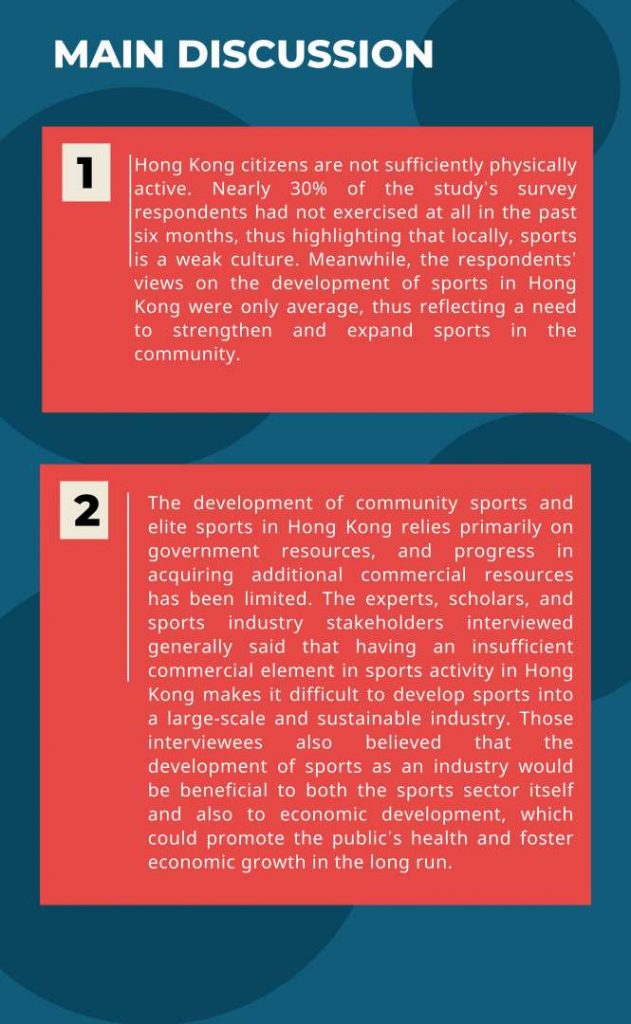
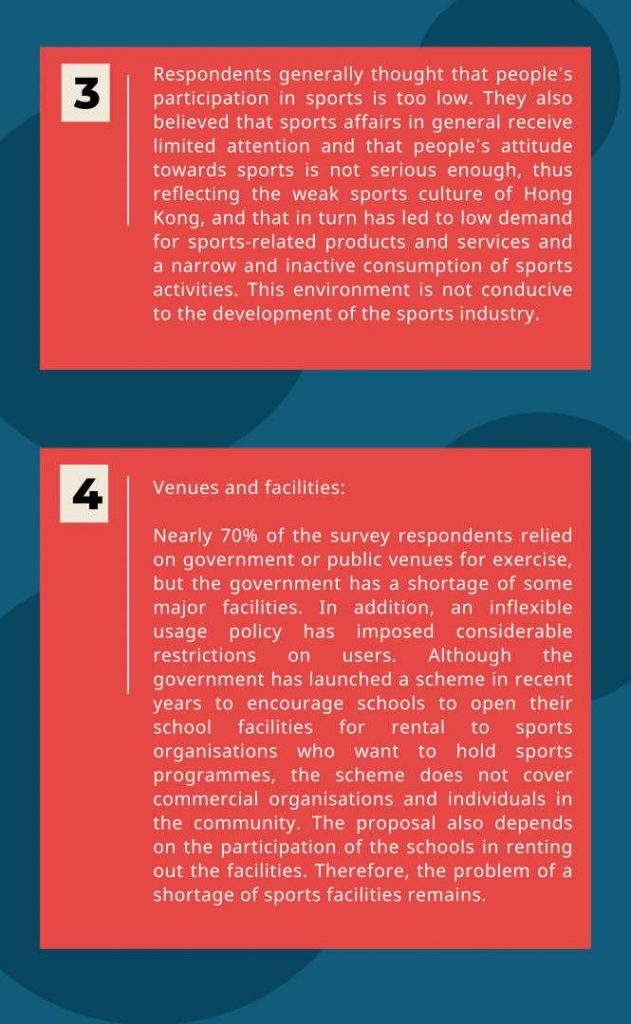
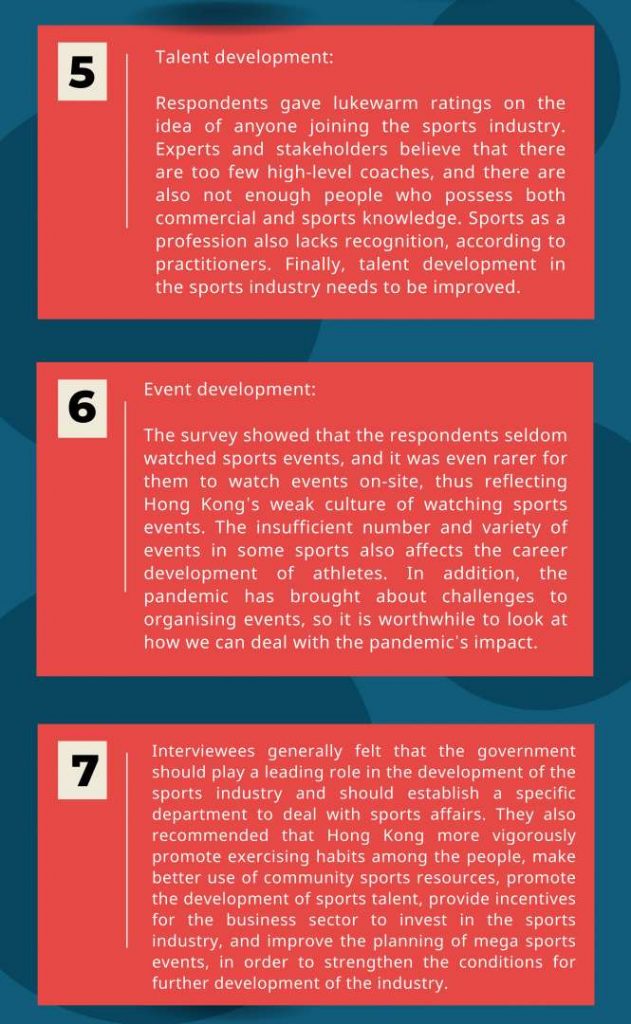
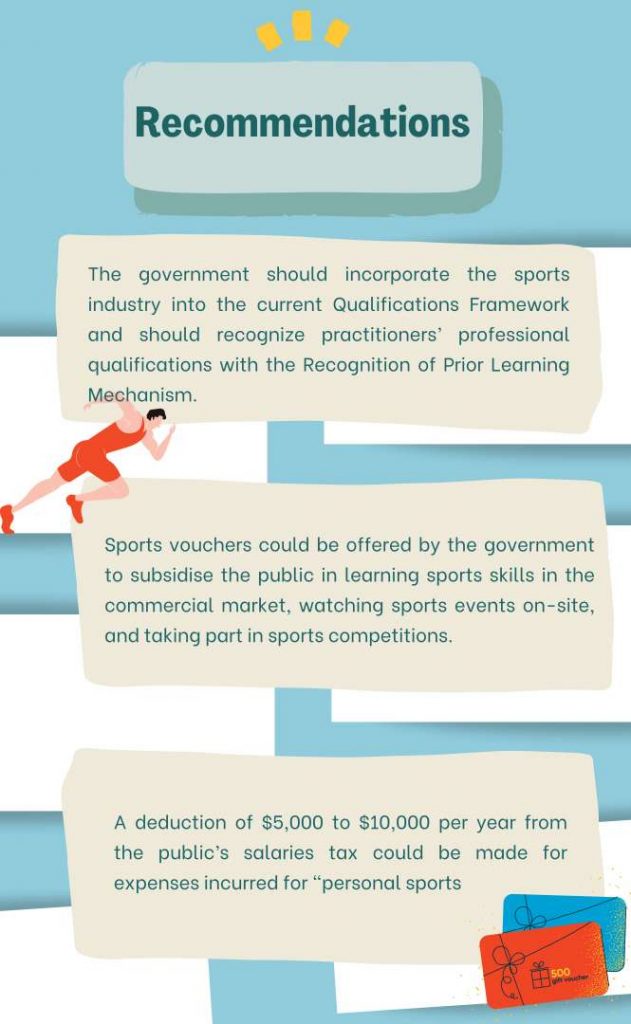
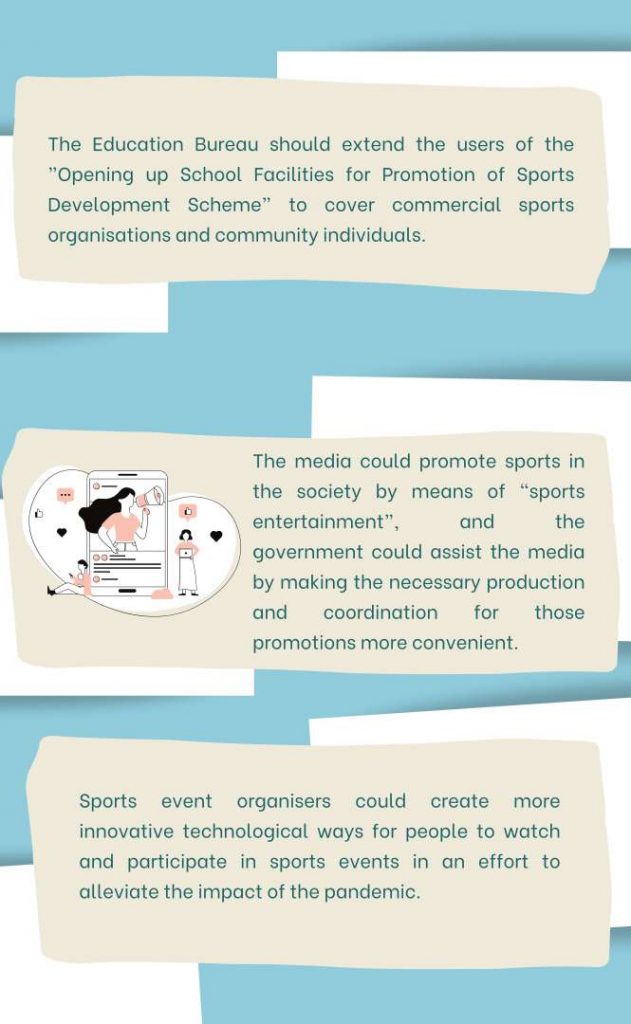
[1] Sports Federation and Olympic Committee of Hong Kong, China. (8 August 2021). “Tokyo 2020 Olympic Games was rounded off Hong Kong, China Delegation clinched best-ever result!” Retrieved 30 September 2021 from https://www.hkolympic.org/archive/press-release/?currentPage=1&id=647
[2] Hong Kong Paralympic Committee & Sports Association for the Physically Disabled. (5 September 2021). “Curtain Fell on Tokyo 2020 Paralympics Hong Kong Gained 2 Silver and 3 Bronze”. Retrieved 30 September 2021 from https://hksapd.org/home/content.php?id=3175&locale=en
[3] Department of Health. (2021). “Level of physical activity by WHO recommendations.” Retrieved 8 December 2021 from https://www.chp.gov.hk/en/statistics/data/10/280/6626.html
[4] Read chapter 3 of this report.
[5] Plunkett Research. “Sports Industry Statistic and Market Size Overview, Business and Industry Statistics”. Retrieved September 14, 2021 from https://www.plunkettresearch.com/statistics/Industry-Statistics-Sports-Industry-Statistic-and-Market-Size-Overview/
[6] Trading Economics. “United States GDP”. Retrieved September 14, 2021 from https://tradingeconomics.com/united-states/gdp
[7] National Bureau of Statistics. (2020). “Announcement on the overall scale and added value of the sports industry in the country in 2019”. Retrieved 14 September 2021 from http://www.stats.gov.cn/tjsj/zxfb/202012/t20201231_1811943.html [in Chinese]
[8] The State Council of PRC website. (2020). “GDP of my country was 1 trillion in 2019, an increase of 6.1%”. Retrieved 14 September 2021 from http://www.gov.cn/xinwen/2020-01/18/content_5470531.htm
[9] Census and Statistics Department. (2021). Hong Kong monthly digest of statistics feature article: Sports and related activities in Hong Kong. Hong Kong: C & SD
[10] HKSARG Press Release. (10 August 2021). “CE announces measures to further promote sports development.”
Publication
- Executive Summary
- Report PowerPoint (Chinese only)
- Full Report (Chinese only)
- Press Release (Chinese only)
Photos


